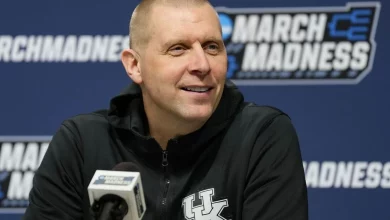Is Ryan Day able to prevent ‘poachers’ from invading Ohio State?

In the competitive world of college football, one of the greatest challenges for any head coach is protecting their program from poachers—coaches, programs, or recruiters that seek to plunder talent, disrupt the structure, or lure away key assets. Ryan Day, the head coach of Ohio State football, has proven himself to be an elite coach since taking over the program, following the legendary Urban Meyer. However, as the Buckeyes continue to thrive and maintain their elite status, they face an ever-growing threat: the poachers. From rival teams poaching assistant coaches to other programs targeting Ohio State’s high-profile recruits, there’s a constant battle for the soul of the program. So, is Ryan Day equipped to prevent poachers from invading Ohio State and maintaining the program’s dominance?
This article explores the phenomenon of poaching in college football, the specific challenges Day faces as Ohio State’s head coach, and whether he has the tools to ensure that his program remains resilient and impervious to external threats. We’ll also examine the methods Ryan Day has employed thus far to prevent poaching and whether these efforts will be sufficient in the face of increased competition both on and off the field.
1. The Poaching Phenomenon in College Football
In the high-stakes world of college football, poaching can take many forms. At its core, poaching refers to the act of stealing something valuable from a rival program, be it players, coaches, or even entire recruiting classes. The competition for talent is fierce, and every program wants to secure the best available players and the brightest minds to lead them.
However, poaching isn’t just about trying to lure away top recruits or star players—it can also refer to stealing assistant coaches or even entire coaching staffs. In today’s landscape, coaching staffs are incredibly important to the success of a program. Assistant coaches, in particular, play crucial roles in recruiting, player development, and strategic planning. Losing a key assistant coach can drastically affect a program’s performance, and for a powerhouse like Ohio State, poaching is an ever-present concern.
Poachers can come in the form of rival teams, smaller programs looking to make a splash, or even powerhouses from other conferences. The dynamics of college football recruiting and coaching are shifting quickly, and the rise of the transfer portal and NIL (Name, Image, and Likeness) deals has introduced new challenges in retaining talent both on and off the field.
2. Ryan Day’s Initial Success at Ohio State
Since Ryan Day took over as head coach of Ohio State in 2019, he has continued the winning tradition established by Urban Meyer. Day has quickly proven himself as one of the brightest minds in college football, with an offensive philosophy that has been both high-powered and efficient. His ability to recruit top talent has ensured that Ohio State remains at the top of college football, consistently competing for Big Ten championships and College Football Playoff berths.
Day’s success has not gone unnoticed. He has helped solidify Ohio State as one of the premier programs in the country, regularly attracting the nation’s best high school recruits and transfer portal talent. His offensive expertise has turned quarterbacks like Justin Fields and CJ Stroud into Heisman contenders, while his ability to build a formidable supporting cast has ensured that Ohio State remains one of the most feared teams in college football.
However, the success that Ryan Day has enjoyed has made Ohio State a target for rival programs. As the program continues to perform at the highest level, rival teams—especially those in the SEC, Big Ten, and other power conferences—are constantly looking for ways to destabilize Ohio State’s recruiting advantage. Poachers are always looking for cracks in the armor, and Day must ensure that the program remains resilient and strong.
3. The Poaching Threats Ohio State Faces Under Ryan Day
While Ohio State remains a powerhouse, it’s not immune to the pressures of the modern college football landscape. The combination of the transfer portal, NIL opportunities, and the high turnover of coaching staffs has created an environment where poaching is a constant threat. For Ryan Day, the challenge is not only retaining talent but also making sure his coaching staff remains intact, as assistant coaches are often targets for other programs seeking to enhance their own teams.
Here are the primary types of poaching threats that Ohio State faces:
1. Poaching Recruits
Ohio State’s elite recruiting classes are the bedrock of the program’s success, but with success comes the inevitable interest from other programs. While Ohio State has consistently been a top destination for elite recruits, there are programs—especially in the SEC—that have the ability to offer lucrative NIL deals and an attractive football culture that can sway some recruits away from the Buckeyes.
One of the greatest challenges Ryan Day faces is ensuring that Ohio State’s roster stays stocked with the best and brightest talent in the country. While Ohio State’s reputation and track record of developing NFL talent give them a significant advantage in the recruiting process, the changing landscape of college football presents new hurdles. Programs that are aggressive with NIL offers and transfer portal poaching can lure players away from Ohio State, potentially leading to a talent drain.
2. Poaching Assistant Coaches
The value of a strong coaching staff cannot be overstated in college football. Assistant coaches are often the lifeblood of a program, handling key aspects of player development, recruiting, and game planning. Given Ohio State’s recent success, Day’s assistant coaches are highly coveted by other programs looking to elevate their own teams.
From offensive coordinators to defensive backs coaches, Ohio State’s staff has produced some of the brightest minds in college football. As teams look to upgrade their coaching staff, these assistants become prime targets for poaching. Jim Knowles, the Buckeyes’ defensive coordinator, for example, has had success in turning Ohio State’s defense into a more aggressive and disciplined unit, making him a potential target for teams looking to improve defensively.
The question for Ryan Day is whether he can retain these highly sought-after assistant coaches in the face of poaching efforts. While Ohio State’s salary structure and status within the college football landscape give the program some advantage, the lure of a head coaching position or a more lucrative offer can be enough to tempt assistant coaches to leave.
3. Poaching Players via the Transfer Portal
The introduction of the transfer portal has added a new layer of complexity to the world of poaching. Now, players can transfer from one school to another with relative ease, and schools can pick up players who are looking for a change of scenery. While Ohio State benefits from being an attractive landing spot for transfer players, it also faces the risk of losing players who see an opportunity to transfer elsewhere for more playing time or a better NIL deal.
Players such as Jaxon Smith-Njigba and Emeka Egbuka have been huge contributors to Ohio State’s success, but the reality is that programs can now recruit players out of the portal—often taking advantage of players’ dissatisfaction with their current situation. Ryan Day must find ways to create an environment that not only attracts top-tier recruits but also convinces existing players to stay in the fold.
4. Poaching Coaches as Head Coaches
It’s also worth noting that Ohio State’s success under Ryan Day has made him a potential target for other programs looking to hire a head coach. While Day is currently entrenched as the leader of the Buckeyes, there are always programs in search of a new face to lead their teams, and with his track record of success, Day could be the ideal candidate for a higher-profile job at a different program.
Although Ohio State is one of the most prestigious football programs in the country, the potential for Day to be lured away by a larger program or a more lucrative offer exists. If poachers came for Day, Ohio State would need a strong succession plan in place to avoid any long-term disruptions.
4. How Ryan Day Can Prevent Poaching
Preventing poaching in the modern landscape of college football is no easy task. Ryan Day’s ability to prevent poachers from infiltrating Ohio State and maintaining the stability of the program will depend on several key strategies:
1. Retaining Talent Through NIL and Player Development
One of the most important aspects of maintaining stability in a program is ensuring that players feel valued both on and off the field. By capitalizing on the growing importance of NIL opportunities, Ryan Day can create a system where players not only get the exposure and development they need to succeed but also secure lucrative endorsement deals. Providing a well-rounded experience for student-athletes, both on and off the field, will keep players engaged with the program and deter them from leaving for programs with more enticing offers.
Additionally, continued success in player development—particularly by sending players to the NFL—will bolster Ohio State’s standing as a pipeline for elite talent. Ensuring that players are well-prepared for life after college will continue to make Ohio State an attractive destination.
2. Building a Stronger Culture of Loyalty
Ohio State’s tradition and success speak for themselves, but creating a culture of loyalty is also vital. Ryan Day must foster an environment where players and coaches feel connected to the team and its mission. Players and coaches should be motivated by the legacy of Ohio State football and a desire to be part of something bigger than just individual success.
By emphasizing the importance of the team and community, Ryan Day can cultivate loyalty among his staff and players, reducing the risk of poaching.
3. Strengthening the Coaching Staff and Succession Planning
Ryan Day’s ability to keep his assistant coaches and coordinators will be one of the greatest challenges in preventing poaching. One way to retain top-tier assistants is by ensuring they are compensated fairly and have the opportunity to grow within the program. By creating a culture of professional development, Day can make Ohio State an attractive place for assistant coaches to stay long-term.
Moreover, succession planning is crucial. Having a system in place to identify and groom the next generation of leaders within the program will minimize disruption if any of the current coaching staff decide to leave for other opportunities.
A Continuing Battle for Stability
Ryan Day’s ability to prevent poachers from invading Ohio State will be one of the key factors in maintaining the program’s elite status. While no program is impervious to the forces of poaching, Ohio State’s tradition, resources, and coaching acumen give Day the tools to mitigate these threats. By retaining top talent, fostering a strong culture of loyalty, and ensuring his coaching staff is supported and valued, Day can continue to lead Ohio State to sustained success.
The fight to keep poachers at bay will always be a challenge for any elite program, but with Ryan Day at the helm, Ohio State is in good hands. However, the poaching game is one that requires constant vigilance, and Day will need to adapt quickly to the changing landscape of college football to ensure that Ohio State remains at the top.









